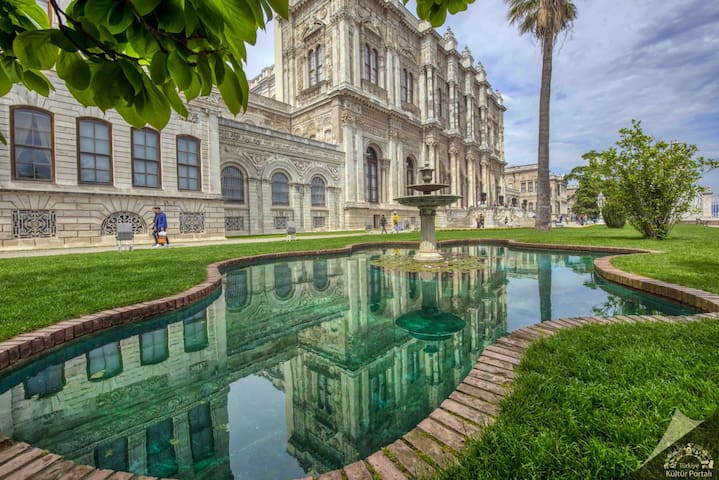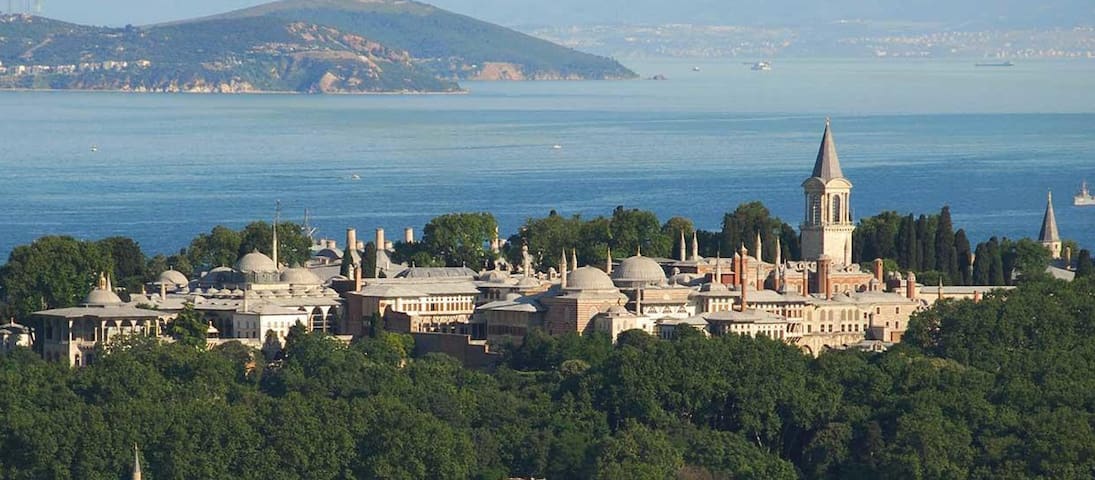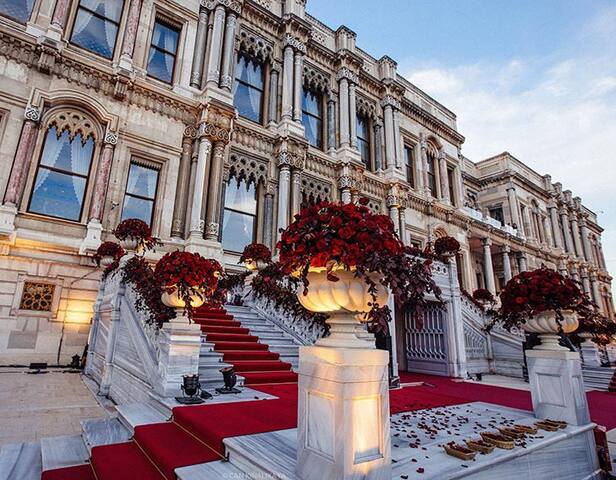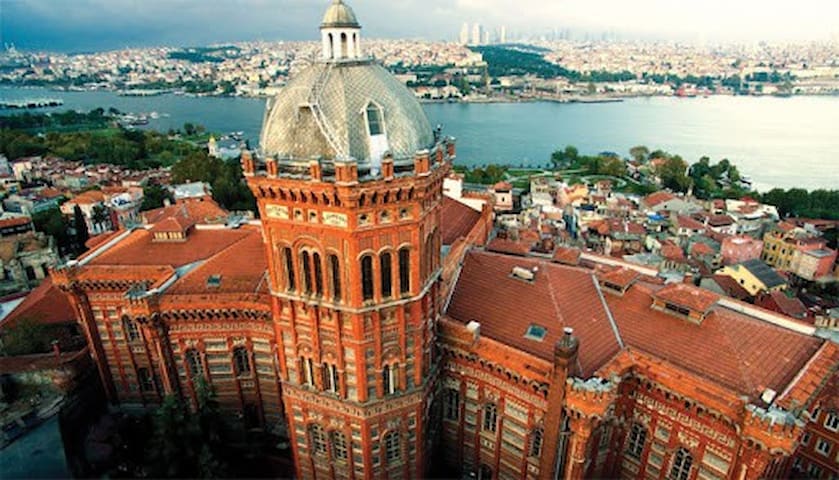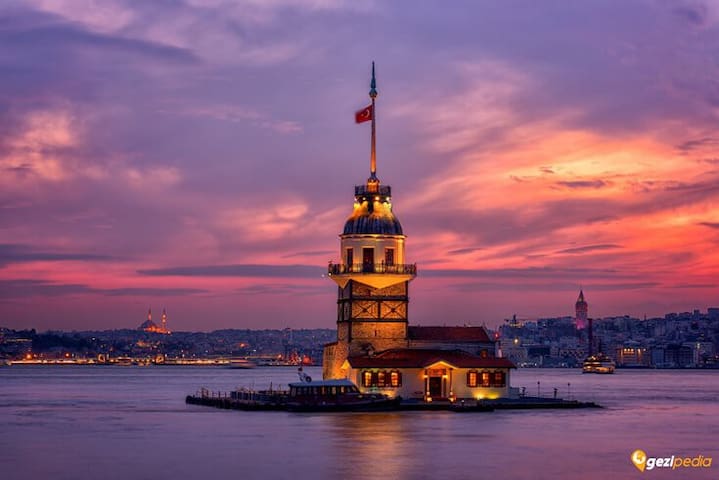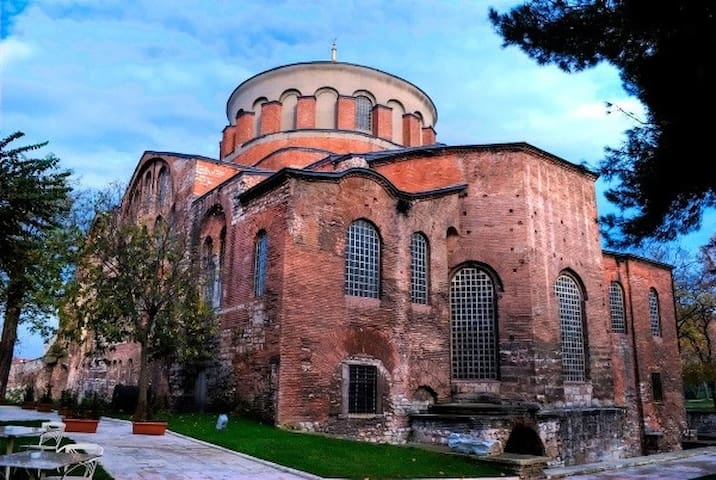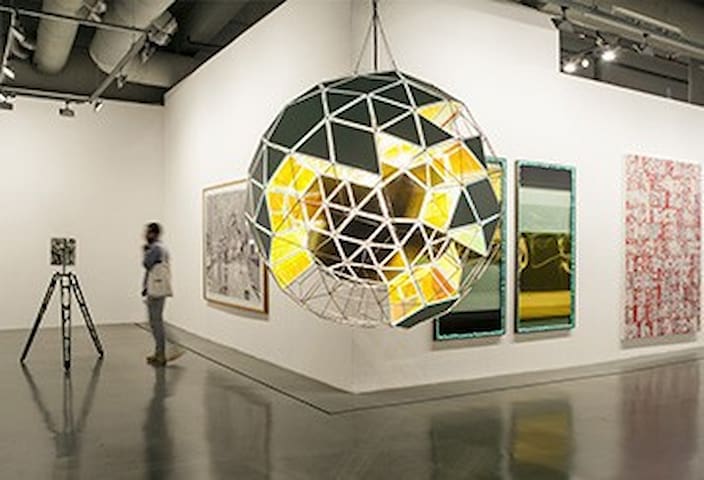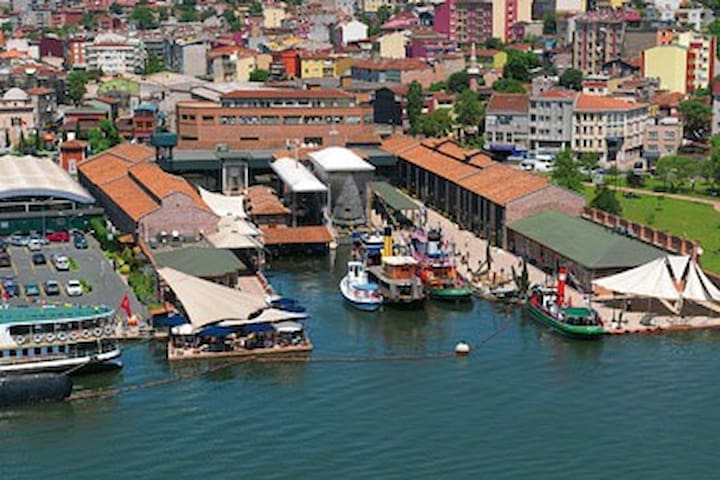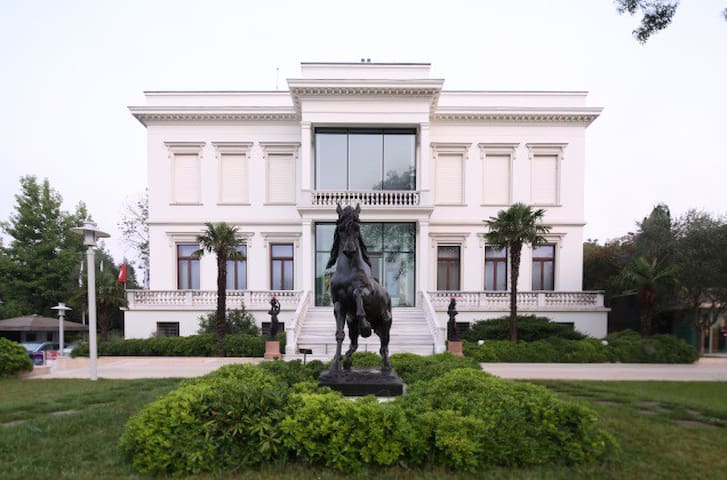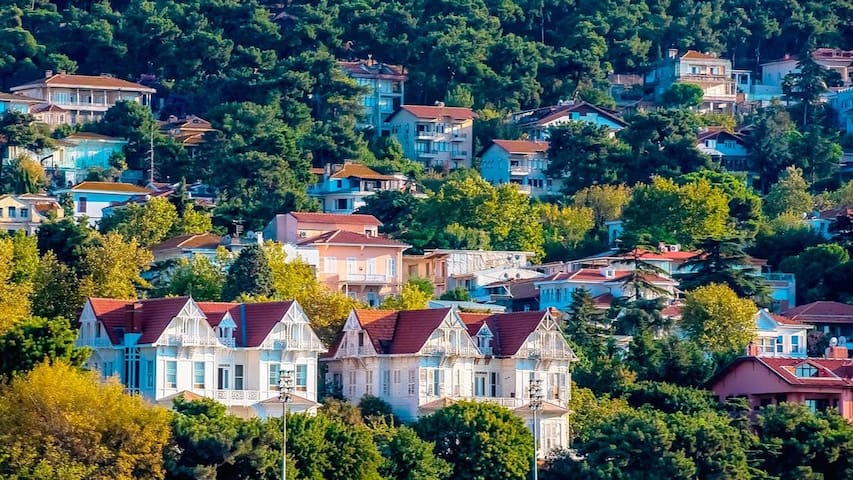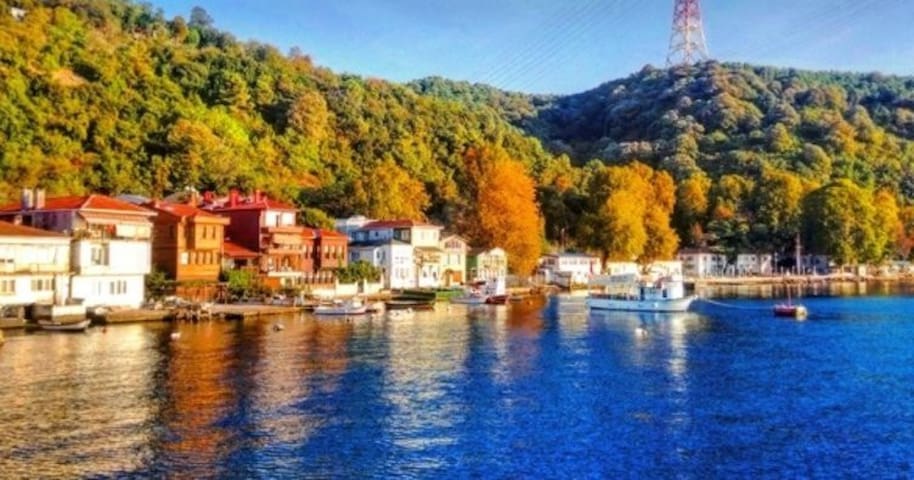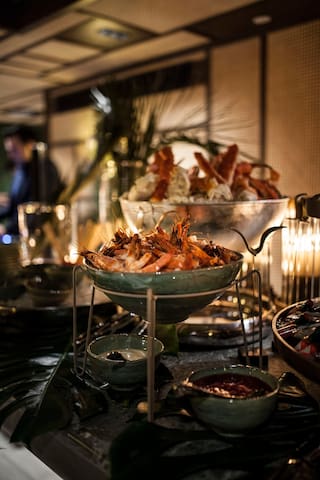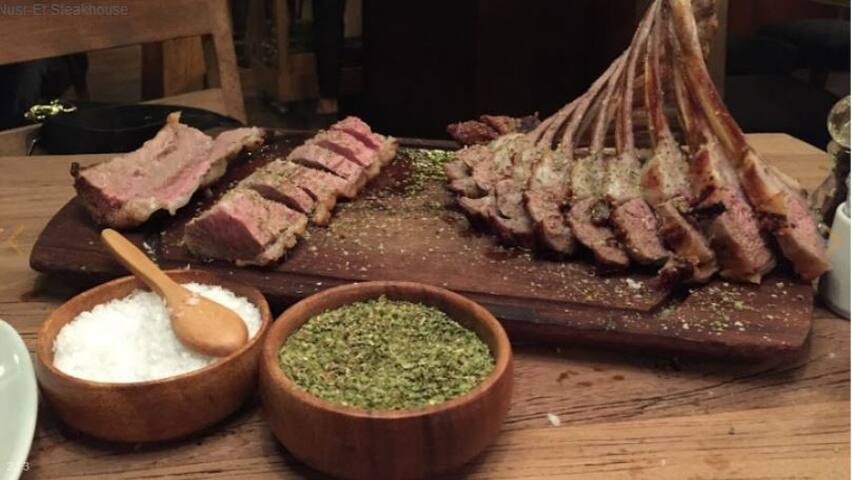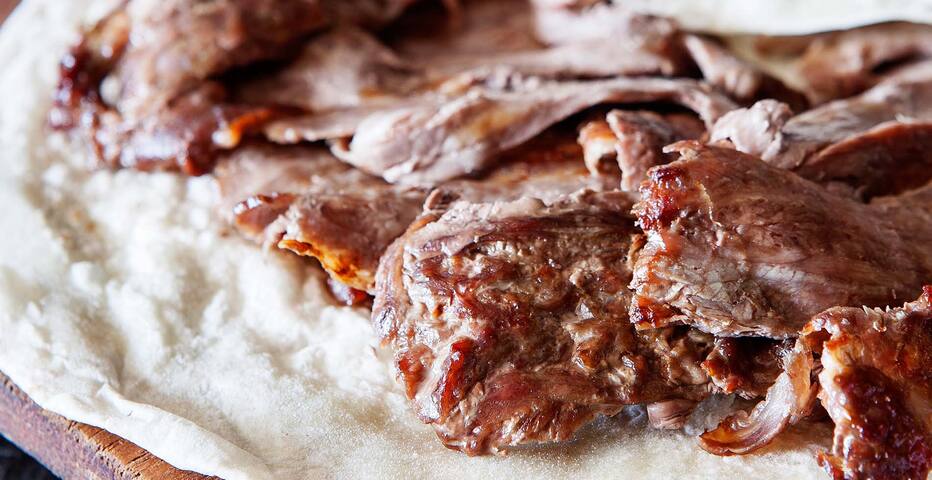Gezilecek yerler
Dolmabahçe as a 19th Century Palace
The coastal area of Beşiktaş, where Dolmabahçe Palace is located, is an area that has been the scene of shipping activities in the past as one of the bays of the Bosphorus. This bay, which was a natural harbor for ships to take refuge since antiquity, also attracted the rulers during the Byzantine period and royal palaces were built in this region.
The coastal area, which served as a port where navy ships were anchored and maritime ceremonies were performed during the Ottoman period, was named “dolmabağçe” after the sea was filled in the 16th century. Although the official residence was Topkapı Palace, the “dolmabağçe” region became one of the preferred places to visit and has been used as a royal garden belonging to the sultan and the dynasty. In the 19th century, the group of mansions and pavilions built on this garden were collectively called “Beşiktaş Coastal Palace”. The influence of the trend of renewal and modernization of the 19th century was also reflected in the palaces, as well as in the culture and administration of the Ottoman Empire. Dolmabahçe Palace, which has the title of being the third largest palace structure of Istanbul today, is the most magnificent work created by this trend of renewal.
The structures of Beşiktaş Coastal Palace were considered to be incomplete in terms of functionality during the reign of Sultan Abdülmecid (1839-1861). These structures were demolished and Dolmabahçe Palace was built in their place during this period. The construction of the palace started on June 13, 1843, and was completed on June 7, 1856. It is situated on an area of 110 thousand square meters, dominating the magnificent view of the Bosphorus..
580 personas locales recomiendan
Dolmabahce Palace
Dolmabahçe CaddesiDolmabahçe as a 19th Century Palace
The coastal area of Beşiktaş, where Dolmabahçe Palace is located, is an area that has been the scene of shipping activities in the past as one of the bays of the Bosphorus. This bay, which was a natural harbor for ships to take refuge since antiquity, also attracted the rulers during the Byzantine period and royal palaces were built in this region.
The coastal area, which served as a port where navy ships were anchored and maritime ceremonies were performed during the Ottoman period, was named “dolmabağçe” after the sea was filled in the 16th century. Although the official residence was Topkapı Palace, the “dolmabağçe” region became one of the preferred places to visit and has been used as a royal garden belonging to the sultan and the dynasty. In the 19th century, the group of mansions and pavilions built on this garden were collectively called “Beşiktaş Coastal Palace”. The influence of the trend of renewal and modernization of the 19th century was also reflected in the palaces, as well as in the culture and administration of the Ottoman Empire. Dolmabahçe Palace, which has the title of being the third largest palace structure of Istanbul today, is the most magnificent work created by this trend of renewal.
The structures of Beşiktaş Coastal Palace were considered to be incomplete in terms of functionality during the reign of Sultan Abdülmecid (1839-1861). These structures were demolished and Dolmabahçe Palace was built in their place during this period. The construction of the palace started on June 13, 1843, and was completed on June 7, 1856. It is situated on an area of 110 thousand square meters, dominating the magnificent view of the Bosphorus..
The Ottoman Palace, famous for being one of the most beautiful landscapes that make up Istanbul's skyline, a treasure trove of history on the historical peninsula.
Following the conquest of Istanbul in 1453, the construction of the Topkapı Palace was started in 1460 at the request of Fatih Sultan Mehmet and was completed in 1478. Topkapı Palace, which was not built simultaneously with all the additional buildings, such as the case is with Dolmabahçe Palace, was enlarged with the supplementary buildings added until the 19th century.
Topkapı Palace is located in one of the oldest historical regions of Istanbul. Located on the historical Istanbul peninsula between the Marmara Sea, the Bosphorus and the Golden Horn, the palace is one of the iconic structures of Istanbul. Topkapı Palace, established on an area of 700,000 square meters on the Eastern Roman acropolis in Sarayburnu, was the administrative, educational and artistic center of the empire for approximately four hundred years from Fatih Sultan Mehmet to the 31st Sultan Abdülmecid, as well as housing the dynasty. Although Topkapı Palace was gradually abandoned by the mid-19th century when the dynasty slowly moved to Dolmabahçe Palace, it preserved its historical importance and value.
After the founding of the Republic of Turkey, Topkapı Palace was converted into a museum on April 3, 1924, having the distinction of being the first museum of the Republic. Today, Topkapı Palace is one of the largest palace-museums in the world with its buildings, architecture, collections and approximately 300,000 archive documents.
Upon entering the sultanate gate, the palace structures consist of four transitional courtyards and the surrounding architectural structures. Among the palace structures surrounded by gardens and squares, are the first courtyard known as Alay Square, Hagia Eirene Church, Royal Mint, bakery, hospital, wood warehouse, and wicker makers' house.
The second courtyard of the palace is Divan Square, notable for being where the state administration takes place, also called Justice Square. Divan-ı Hümayun (Kubbealtı), the scene of many ceremonies throughout history, was the official meeting place of the Divan council, and the treasury is located right next to it. The Justice Tower is located behind the Divan structure, the entrance to the Harem next to Kubbealtı, with the courtyard also housing the Ward of the “Zülüflü” Guards (The Tressed Halberdiers) and the Royal Stables.
The third courtyard of the palace is also called Enderun Courtyard. In this section houses the Sultan's Audience Hall, Enderun Treasure, the Privy Room, as well as structures such as the Palace School established during the reign of Sultan Murat II.
In the fourth courtyard, which is the last courtyard, there are pavilions and hanging gardens of the Sultan. In this section, there are the Baghdad and Revan Pavilions and the Iftaree Gazebo, which are the most distinguished and aesthetically advanced examples of Ottoman classical mansion architecture. In the lower part of the fourth courtyard, Mecidiye Pavilion and the Wardrobe Chamber are the last buildings of the palace.
717 personas locales recomiendan
Topkapi Palace
The Ottoman Palace, famous for being one of the most beautiful landscapes that make up Istanbul's skyline, a treasure trove of history on the historical peninsula.
Following the conquest of Istanbul in 1453, the construction of the Topkapı Palace was started in 1460 at the request of Fatih Sultan Mehmet and was completed in 1478. Topkapı Palace, which was not built simultaneously with all the additional buildings, such as the case is with Dolmabahçe Palace, was enlarged with the supplementary buildings added until the 19th century.
Topkapı Palace is located in one of the oldest historical regions of Istanbul. Located on the historical Istanbul peninsula between the Marmara Sea, the Bosphorus and the Golden Horn, the palace is one of the iconic structures of Istanbul. Topkapı Palace, established on an area of 700,000 square meters on the Eastern Roman acropolis in Sarayburnu, was the administrative, educational and artistic center of the empire for approximately four hundred years from Fatih Sultan Mehmet to the 31st Sultan Abdülmecid, as well as housing the dynasty. Although Topkapı Palace was gradually abandoned by the mid-19th century when the dynasty slowly moved to Dolmabahçe Palace, it preserved its historical importance and value.
After the founding of the Republic of Turkey, Topkapı Palace was converted into a museum on April 3, 1924, having the distinction of being the first museum of the Republic. Today, Topkapı Palace is one of the largest palace-museums in the world with its buildings, architecture, collections and approximately 300,000 archive documents.
Upon entering the sultanate gate, the palace structures consist of four transitional courtyards and the surrounding architectural structures. Among the palace structures surrounded by gardens and squares, are the first courtyard known as Alay Square, Hagia Eirene Church, Royal Mint, bakery, hospital, wood warehouse, and wicker makers' house.
The second courtyard of the palace is Divan Square, notable for being where the state administration takes place, also called Justice Square. Divan-ı Hümayun (Kubbealtı), the scene of many ceremonies throughout history, was the official meeting place of the Divan council, and the treasury is located right next to it. The Justice Tower is located behind the Divan structure, the entrance to the Harem next to Kubbealtı, with the courtyard also housing the Ward of the “Zülüflü” Guards (The Tressed Halberdiers) and the Royal Stables.
The third courtyard of the palace is also called Enderun Courtyard. In this section houses the Sultan's Audience Hall, Enderun Treasure, the Privy Room, as well as structures such as the Palace School established during the reign of Sultan Murat II.
In the fourth courtyard, which is the last courtyard, there are pavilions and hanging gardens of the Sultan. In this section, there are the Baghdad and Revan Pavilions and the Iftaree Gazebo, which are the most distinguished and aesthetically advanced examples of Ottoman classical mansion architecture. In the lower part of the fourth courtyard, Mecidiye Pavilion and the Wardrobe Chamber are the last buildings of the palace.
The name Çırağan is derived from the Persian word "cerag" meaning torch. Because of the famous Ottoman festivals held in the tulip gardens decorated with torches in the evening, the area where the palace was located was called Ceragan, it was called the Çırağan Festival.
The palace was built during the reign of Sultan Abdülmecit and was designed by the Armenian architect Nigogos Balyan.
It was built on the European shores of the Bosphorus, between Beşiktaş and Ortaköy neighborhoods. Construction took about 12 years. This was the last palace the Ottoman Empire built for the royal family.
The main building was destroyed in a fire in the central heating vents in 1910 and only the outer walls remained. However, with the addition of a renovated and modern hotel building in the 90s, the palace was restored.
25 personas locales recomiendan
Çırağan Sarayı
No:84 Çırağan Cd.The name Çırağan is derived from the Persian word "cerag" meaning torch. Because of the famous Ottoman festivals held in the tulip gardens decorated with torches in the evening, the area where the palace was located was called Ceragan, it was called the Çırağan Festival.
The palace was built during the reign of Sultan Abdülmecit and was designed by the Armenian architect Nigogos Balyan.
It was built on the European shores of the Bosphorus, between Beşiktaş and Ortaköy neighborhoods. Construction took about 12 years. This was the last palace the Ottoman Empire built for the royal family.
The main building was destroyed in a fire in the central heating vents in 1910 and only the outer walls remained. However, with the addition of a renovated and modern hotel building in the 90s, the palace was restored.
The Ecumenical Patriarchate of Constantinople is one of the fourteen to sixteen autocephalous churches that together compose the Eastern Orthodox Church. It is headed by the Ecumenical Patriarch of Constantinople, currently Bartholomew I, Archbishop of Constantinople.
Because of its historical location as the capital of the former Eastern Roman (Byzantine) Empire and its role as the mother church of most modern Orthodox churches, Constantinople holds a special place of honor within Orthodoxy and serves as the seat for the Ecumenical Patriarch, who enjoys the status of primus inter pares (first among equals) among the world's Eastern Orthodox prelates and is regarded as the representative and spiritual leader of Orthodox Christians.
The Ecumenical Patriarchate promotes the expansion of the Christian faith and Eastern Orthodox doctrine, and the Ecumenical Patriarchs are involved in ecumenism and interfaith dialogue, charitable work, and the defense of Orthodox Christian traditions.
92 personas locales recomiendan
Ecumenical Orthodox Patriarchate
No:19 Dr. Sadık Ahmet Cd.The Ecumenical Patriarchate of Constantinople is one of the fourteen to sixteen autocephalous churches that together compose the Eastern Orthodox Church. It is headed by the Ecumenical Patriarch of Constantinople, currently Bartholomew I, Archbishop of Constantinople.
Because of its historical location as the capital of the former Eastern Roman (Byzantine) Empire and its role as the mother church of most modern Orthodox churches, Constantinople holds a special place of honor within Orthodoxy and serves as the seat for the Ecumenical Patriarch, who enjoys the status of primus inter pares (first among equals) among the world's Eastern Orthodox prelates and is regarded as the representative and spiritual leader of Orthodox Christians.
The Ecumenical Patriarchate promotes the expansion of the Christian faith and Eastern Orthodox doctrine, and the Ecumenical Patriarchs are involved in ecumenism and interfaith dialogue, charitable work, and the defense of Orthodox Christian traditions.
The Galata Tower was built by the Genoese in mid-fourteenth century as part of the Galata Walls when Galata quarter was a Genoese colony in the Byzantine Era. After it was used as a dungeon for some time in the Ottoman Era, it was converted to a fire lookout tower. The tower which suffered damages due to earthquakes and fires from time to time underwent several renovations during the Ottoman Era. The tower that had fallen into ruins by 1960s was restored by Istanbul Municipality and opened for visitors. The Galata Tower was restored by the General Directorate of Foundations in 2020, and the reinforced concrete elements which were added later, and the cafeteria were removed, and the Tower reopened its gates to visitors as a museum.
In the Galata Tower museum, artefacts are displayed, reflecting all the historical periods of Istanbul that has been populated since prehistoric times and served as a capital for sixteen centuries for three great empires. One of the tallest buildings in Istanbul until the mid-20th century, the Galata Tower has one of the most beautiful panoramic views of Istanbul that you can enjoy on the top floor. The Tower is in the tentative list of Unesco World Heritage Sites along with the Genoese Towers in the Mediterranean and the Black Sea.
Now That You Are Here
You are at walking distance to Galata Mevlevi Lodge, the first Mevlevi lodge of Istanbul and the most important Ottoman work of art in Beyoğlu. Also, if you walk up from the Tower to İstiklal Avenue, you can visit Tarık Tunaya Cultural Center which is free for visitors.
1235 personas locales recomiendan
Galata Tower
The Galata Tower was built by the Genoese in mid-fourteenth century as part of the Galata Walls when Galata quarter was a Genoese colony in the Byzantine Era. After it was used as a dungeon for some time in the Ottoman Era, it was converted to a fire lookout tower. The tower which suffered damages due to earthquakes and fires from time to time underwent several renovations during the Ottoman Era. The tower that had fallen into ruins by 1960s was restored by Istanbul Municipality and opened for visitors. The Galata Tower was restored by the General Directorate of Foundations in 2020, and the reinforced concrete elements which were added later, and the cafeteria were removed, and the Tower reopened its gates to visitors as a museum.
In the Galata Tower museum, artefacts are displayed, reflecting all the historical periods of Istanbul that has been populated since prehistoric times and served as a capital for sixteen centuries for three great empires. One of the tallest buildings in Istanbul until the mid-20th century, the Galata Tower has one of the most beautiful panoramic views of Istanbul that you can enjoy on the top floor. The Tower is in the tentative list of Unesco World Heritage Sites along with the Genoese Towers in the Mediterranean and the Black Sea.
Now That You Are Here
You are at walking distance to Galata Mevlevi Lodge, the first Mevlevi lodge of Istanbul and the most important Ottoman work of art in Beyoğlu. Also, if you walk up from the Tower to İstiklal Avenue, you can visit Tarık Tunaya Cultural Center which is free for visitors.
The Maiden’s Tower is located 150-200 meters off the shore of the Salacak district in Üsküdar. Although it is not definite as to when the Maiden’s Tower was built, the tower’s architectural style is said by some sources to be from around 340 BCE.
The Maiden’s Tower has been used for many different purposes over time, such as a tax collection area from merchantman, a defense tower, and a lighthouse. During the cholera epidemic in 1830, it was used as a quarantine hospital and radio station. During the Republic Period, it was again used as a light house for a little while.
Visiting of Maiden’s Tower
Maiden’s Tower is museum and restaurant are opens at 365 day in a year.Visitor can visit it from 09:00 a.m to 19:00 p.m
Visitors do not need any reservation to go to Miaden’s Tower and after coming tower everyone can benefit from restaurant or cafeteria .
Museum entrance:
Adults 40 TL per person.
Student 20 TL per person (student card)
325 personas locales recomiendan
Maiden's Tower
Salacak MevkiiThe Maiden’s Tower is located 150-200 meters off the shore of the Salacak district in Üsküdar. Although it is not definite as to when the Maiden’s Tower was built, the tower’s architectural style is said by some sources to be from around 340 BCE.
The Maiden’s Tower has been used for many different purposes over time, such as a tax collection area from merchantman, a defense tower, and a lighthouse. During the cholera epidemic in 1830, it was used as a quarantine hospital and radio station. During the Republic Period, it was again used as a light house for a little while.
Visiting of Maiden’s Tower
Maiden’s Tower is museum and restaurant are opens at 365 day in a year.Visitor can visit it from 09:00 a.m to 19:00 p.m
Visitors do not need any reservation to go to Miaden’s Tower and after coming tower everyone can benefit from restaurant or cafeteria .
Museum entrance:
Adults 40 TL per person.
Student 20 TL per person (student card)
TWO CONTINENTS, ONE MUSEUM
The Fortress Museum incorporates Rumeli, Yedikule and Anadolu Fortresses. Among all, Rumeli Fortress however clearly stands out. The Fortress covering a 30-acre area in Sarıyer, also gives its name to the location. It was built in a short period of four months by Mehmet the Conqueror in 1452 before the conquest of Istanbul in order to prevent attacks and block aids from the north of Bosphorus.
This monument is located opposite the Anadolu Fortress, built by Sultan I. Beyazıt in 1394, and is located in the narrowest part of the Bosphorus.
The mosque which was built during Rumelihisari construction and then which was demolished, was built again in its original form in 2014. It also houses some events.
88 personas locales recomiendan
Rumelihisarı
Yahya Kemal CaddesiTWO CONTINENTS, ONE MUSEUM
The Fortress Museum incorporates Rumeli, Yedikule and Anadolu Fortresses. Among all, Rumeli Fortress however clearly stands out. The Fortress covering a 30-acre area in Sarıyer, also gives its name to the location. It was built in a short period of four months by Mehmet the Conqueror in 1452 before the conquest of Istanbul in order to prevent attacks and block aids from the north of Bosphorus.
This monument is located opposite the Anadolu Fortress, built by Sultan I. Beyazıt in 1394, and is located in the narrowest part of the Bosphorus.
The mosque which was built during Rumelihisari construction and then which was demolished, was built again in its original form in 2014. It also houses some events.
Anadoluhisarı was built between 1393 and 1394 on the commission of the Ottoman Sultan Bayezid I, as part of his preparations for a siege on the then-Byzantine city of Constantinople.
The fortress is situated at the narrowmost point of the Bosporus. Erected primarily as a watch fort. Turkish Ministry of Culture restored the site in 1991 - 1993.
Today, Anadoluhisarı lends a picturesque appearance to its corner of the Bosphorus alongside the timber yalı homes that define the neighborhood, and functions as a historical site, although it is not open to the public.
20 personas locales recomiendan
Anadolu Hisarı
Anadoluhisarı was built between 1393 and 1394 on the commission of the Ottoman Sultan Bayezid I, as part of his preparations for a siege on the then-Byzantine city of Constantinople.
The fortress is situated at the narrowmost point of the Bosporus. Erected primarily as a watch fort. Turkish Ministry of Culture restored the site in 1991 - 1993.
Today, Anadoluhisarı lends a picturesque appearance to its corner of the Bosphorus alongside the timber yalı homes that define the neighborhood, and functions as a historical site, although it is not open to the public.
Istanbul Archaeological Museums are a complex of museums consisting of three main units. The Archaeology Museum, The Museum of Ancient Orient, The Tiled Kiosk Museum. These three separate main units are located in the same garden and house the palace collections formed during the late 19th century by museum director, master painter ("The Tortoise Trainer"/ Pera Museum) and archaeologist Osman Hamdi Bey. Istanbul Archaeological Museum, which is first regular museum appearing in the history of Ottoman Empire and in
Turkey, has about a million artifacts from a variety of cultures, brought from the imperial lands.
The interest in collecting historical artifacts in the Ottoman period dates back to the reign of Mehmet the Conqueror, but the institutional emergence of museums coincides with the establishment of Istanbul Archaeological Museums in 1869 as Müze-i Hümayun (Imperial Museum). Müze-i Humayun, housing the archaeological works collected in the Hagia Irene Church, is the foundation of the Istanbul Archaeological Museum. The Tiled Kiosk built during the reign of Mehmet the Conqueror, was converted into a museum because of the insufficiency of Hagia Irene. The Tiled Kiosk which is still under the administration of Istanbul Archaeological Museum, was restored and opened its doors in 1880.
When Osman Hamdi Bey (Biography) was assigned as the museum director in 1881, there was a breakthrough in Turkish museology. Osman Hamdi Bey excavated in Mount Nemrud, Myrina, Kyme, other Alolia Necropolises and Lagina Hekate Temple and as a result of excavations he conducted in Sayda (Sidon) between 1887-1888, he reached the necropolis of King Sidon and returned to Istanbul with many sarcophagi, especially the famous one; Alexander the Great.
The oldest building (1472 CE) in the Istanbul Archaeological Museum complex is the The Tiled Kiosk. The Tiled Kiosk Museum, which currently displays examples of Turkish tiles and ceramics, is one of the oldest examples of Ottoman civil architecture in Istanbul.
Istanbul Archaeological Museums are among the top 10 museum designed as a museum institution in the world and used for this purpose.The building, which was used as the Museum of Ancient Oriental Works, was constructed by Osman Hamdi Bey in 1883 as Sanayi-i Nefise school, that is, the Academy of Fine Arts. The architect of the building was Alexander Vallaury, who would later build the Istanbul Archaeological Museum Classic building.
The Archaeological Museum stands out as one of the rare buildings constructed as a museum in that time period in the world. It is one of the most beautiful and splendid examples of neo-classical architecture in Istanbul. The inscription in Ottoman Turkish on the pediments of the gates at the entrance of the museum says “Asar-ı Atika Müzesi” (Museum of Antiquities). The tughra on the inscription belongs to Sultan Abdulhamid II.
A new museum building was needed to display magnificent works such as Tomb of Iskender (Alexander Sarcophagus), Tomb of "Crying Women" (Sarcophagus of the mourning women), Lycia Tomb and Tabnit tomb, which were brought to Istanbul from Sidon King Necropolis excavation performed by Osman Hamdi Bey between 1887 and 1888. Across from The Tiled Kiosk, Istanbul Archeological Museums Classical Building, built by the famous architect Alexandre Vallaury, was opened in June 13th 1891.
179 personas locales recomiendan
Istanbul Archaeological Museum
Istanbul Archaeological Museums are a complex of museums consisting of three main units. The Archaeology Museum, The Museum of Ancient Orient, The Tiled Kiosk Museum. These three separate main units are located in the same garden and house the palace collections formed during the late 19th century by museum director, master painter ("The Tortoise Trainer"/ Pera Museum) and archaeologist Osman Hamdi Bey. Istanbul Archaeological Museum, which is first regular museum appearing in the history of Ottoman Empire and in
Turkey, has about a million artifacts from a variety of cultures, brought from the imperial lands.
The interest in collecting historical artifacts in the Ottoman period dates back to the reign of Mehmet the Conqueror, but the institutional emergence of museums coincides with the establishment of Istanbul Archaeological Museums in 1869 as Müze-i Hümayun (Imperial Museum). Müze-i Humayun, housing the archaeological works collected in the Hagia Irene Church, is the foundation of the Istanbul Archaeological Museum. The Tiled Kiosk built during the reign of Mehmet the Conqueror, was converted into a museum because of the insufficiency of Hagia Irene. The Tiled Kiosk which is still under the administration of Istanbul Archaeological Museum, was restored and opened its doors in 1880.
When Osman Hamdi Bey (Biography) was assigned as the museum director in 1881, there was a breakthrough in Turkish museology. Osman Hamdi Bey excavated in Mount Nemrud, Myrina, Kyme, other Alolia Necropolises and Lagina Hekate Temple and as a result of excavations he conducted in Sayda (Sidon) between 1887-1888, he reached the necropolis of King Sidon and returned to Istanbul with many sarcophagi, especially the famous one; Alexander the Great.
The oldest building (1472 CE) in the Istanbul Archaeological Museum complex is the The Tiled Kiosk. The Tiled Kiosk Museum, which currently displays examples of Turkish tiles and ceramics, is one of the oldest examples of Ottoman civil architecture in Istanbul.
Istanbul Archaeological Museums are among the top 10 museum designed as a museum institution in the world and used for this purpose.The building, which was used as the Museum of Ancient Oriental Works, was constructed by Osman Hamdi Bey in 1883 as Sanayi-i Nefise school, that is, the Academy of Fine Arts. The architect of the building was Alexander Vallaury, who would later build the Istanbul Archaeological Museum Classic building.
The Archaeological Museum stands out as one of the rare buildings constructed as a museum in that time period in the world. It is one of the most beautiful and splendid examples of neo-classical architecture in Istanbul. The inscription in Ottoman Turkish on the pediments of the gates at the entrance of the museum says “Asar-ı Atika Müzesi” (Museum of Antiquities). The tughra on the inscription belongs to Sultan Abdulhamid II.
A new museum building was needed to display magnificent works such as Tomb of Iskender (Alexander Sarcophagus), Tomb of "Crying Women" (Sarcophagus of the mourning women), Lycia Tomb and Tabnit tomb, which were brought to Istanbul from Sidon King Necropolis excavation performed by Osman Hamdi Bey between 1887 and 1888. Across from The Tiled Kiosk, Istanbul Archeological Museums Classical Building, built by the famous architect Alexandre Vallaury, was opened in June 13th 1891.
The Hagia Irene located in the outer courtyard of Topkapı Palace is the oldest church of the Eastern Roman Empire (Byzantine). It was also the second largest church in Istanbul after Hagia Sophia. Hagia Irene, originally means “sacred peace” (Hagia Eirene), has a special meaning as the first place where Turkish museology was born.
Hagia Irene, a typical Byzantine structure with its materials and architecture, was built on the site of an old temple in 330. During the reign of Emperor Justinianus, the Nika Revolt in 532 led to the devastation of both Hagia Sophia and the Hagia Irene, and two of them were rebuilt together.
After the fall of Constantinople since the church was not converted into a mosque it was used as loot and gun depot (Harbiye Warehouse) for a long time. In 1846, the first collection of artifacts of Turkish museology was exhibited and in 1869 it became the country's first official museum under the name of Müze-i Hümayun (Imperial Museum). The weapons collection was reorganized and it served as the first Military Museum between 1908 and 1930.
40 personas locales recomiendan
Hagia Irene
1 Topkapı SarayıThe Hagia Irene located in the outer courtyard of Topkapı Palace is the oldest church of the Eastern Roman Empire (Byzantine). It was also the second largest church in Istanbul after Hagia Sophia. Hagia Irene, originally means “sacred peace” (Hagia Eirene), has a special meaning as the first place where Turkish museology was born.
Hagia Irene, a typical Byzantine structure with its materials and architecture, was built on the site of an old temple in 330. During the reign of Emperor Justinianus, the Nika Revolt in 532 led to the devastation of both Hagia Sophia and the Hagia Irene, and two of them were rebuilt together.
After the fall of Constantinople since the church was not converted into a mosque it was used as loot and gun depot (Harbiye Warehouse) for a long time. In 1846, the first collection of artifacts of Turkish museology was exhibited and in 1869 it became the country's first official museum under the name of Müze-i Hümayun (Imperial Museum). The weapons collection was reorganized and it served as the first Military Museum between 1908 and 1930.
Istanbul Modern was founded in 2004 as Turkey’s first museum of modern and contemporary art. Committed to sharing Turkey’s artistic creativity and cultural identity with the local and international art worlds, the museum hosts a broad array of interdisciplinary activities.
Istanbul Modern embraces a global vision to collect, preserve, display and document works of modern and contemporary art, photography, design, architecture, new media and cinema. It acts as an intermediary in the sharing of Turkey’s cultural identity with the international art environment. It supports the artists in their productions and their efforts to form international partnerships. Aspiring to make art easily accessible by the masses, Istanbul Modern provides education programs to art followers of all ages.
Through its collections, exhibitions, and educational programs, the museum aims to instill a love of the arts in visitors from all walks of life and encourage their active participation in the arts. Established in a building occupying an 8,000 square meter site in Karaköy on the shores of the Bosphorus, where it hosted exhibitions and events for 14 years, Istanbul Modern has now moved to a temporary space in Beyoğlu, where it will welcome visitors from May 2018 onward for three years while its new building is being constructed. The museum offers a variety of cultural activities in its permanent and temporary exhibition halls, photography gallery, spaces for educational and social programs, library, cinema and store.
618 personas locales recomiendan
Istanbul Museum of Modern Art
No:1/1 Meşrutiyet Cd.Istanbul Modern was founded in 2004 as Turkey’s first museum of modern and contemporary art. Committed to sharing Turkey’s artistic creativity and cultural identity with the local and international art worlds, the museum hosts a broad array of interdisciplinary activities.
Istanbul Modern embraces a global vision to collect, preserve, display and document works of modern and contemporary art, photography, design, architecture, new media and cinema. It acts as an intermediary in the sharing of Turkey’s cultural identity with the international art environment. It supports the artists in their productions and their efforts to form international partnerships. Aspiring to make art easily accessible by the masses, Istanbul Modern provides education programs to art followers of all ages.
Through its collections, exhibitions, and educational programs, the museum aims to instill a love of the arts in visitors from all walks of life and encourage their active participation in the arts. Established in a building occupying an 8,000 square meter site in Karaköy on the shores of the Bosphorus, where it hosted exhibitions and events for 14 years, Istanbul Modern has now moved to a temporary space in Beyoğlu, where it will welcome visitors from May 2018 onward for three years while its new building is being constructed. The museum offers a variety of cultural activities in its permanent and temporary exhibition halls, photography gallery, spaces for educational and social programs, library, cinema and store.
İstanbul museum of painting and sculpture is Turkey’s first museum of art. With a collection that begins with the late ottoman period and extends to the late 20th century, irhm aims to connect the past and the present by organizing exhibitions and programs that contextualize and re-evaluate history. The main goal of the museum ıs to preserve, expand, interpret and share its collection with the public.
İrhm is committed to creating local, regional and international collaborations while maintaining an innovative attitude. The museum strives to offer critical and creative discussions on art and culture, operating with the belief that the best way of keeping collections pertinent is to continuously develop, support and disseminate research.
As a research-based cultural heritage institution with historical ties to a fine arts university, the museum prioritizes education and creates opportunities for learning.
Istanbul Resim Ve Heykel Muzesi, Mimar Sinan Guzel Sanatlar Universitesi
No:6 Meclis-i Mebusan Cd.İstanbul museum of painting and sculpture is Turkey’s first museum of art. With a collection that begins with the late ottoman period and extends to the late 20th century, irhm aims to connect the past and the present by organizing exhibitions and programs that contextualize and re-evaluate history. The main goal of the museum ıs to preserve, expand, interpret and share its collection with the public.
İrhm is committed to creating local, regional and international collaborations while maintaining an innovative attitude. The museum strives to offer critical and creative discussions on art and culture, operating with the belief that the best way of keeping collections pertinent is to continuously develop, support and disseminate research.
As a research-based cultural heritage institution with historical ties to a fine arts university, the museum prioritizes education and creates opportunities for learning.
The Istanbul Rahmi M.Koç Museum is located on the northern shore of Golden Horn, in Hasköy neighbourhood of Beyoğlu. It lies on three seperate parts of around 28,000 square meters in total: Mustafa V. Koç Building / Historical Lengerhane Building, Historical Dockyard, Open Air Display Area. The Museum collection, in very general terms, consists of communication and transportation items, representing very fine examples of industrial archeology.
81 personas locales recomiendan
Rahmi M. Koc Museum
No:5 Aziz Sk.The Istanbul Rahmi M.Koç Museum is located on the northern shore of Golden Horn, in Hasköy neighbourhood of Beyoğlu. It lies on three seperate parts of around 28,000 square meters in total: Mustafa V. Koç Building / Historical Lengerhane Building, Historical Dockyard, Open Air Display Area. The Museum collection, in very general terms, consists of communication and transportation items, representing very fine examples of industrial archeology.
Sabancı University's Sakıp Sabancı Museum is located in Emirgan, at one of Istanbul's oldest settlements on the Bosphorus.
In 1925, Prince Mehmed Ali Hasan of the Hidiv family of Egypt commissioned the Italian architect Edoardo De Nari to build the villa, now the museum's main building, and it was used as a summer house for many years by various members of the Hidiv family.
After the mansion was purchased in 1951 by industrialist Hacı Ömer Sabancı from the Hidiv family as a summer residence, it came to be known as Atlı Köşk, “The Mansion with the Horse”, because of the statue of a horse (purchased in the same year) that was installed in the garden; the statue is the 1864 work of the French sculptor Louis Doumas.
A second horse sculpture on the grounds of Atlı Köşk that gave the mansion its name is the cast of one of the four horses taken from Sultanahmet square in Istanbul when it was looted by Crusaders during the Fourth Crusade in 1204 and removed to the Basilica of San Marco in Venice.
After the death of Hacı Ömer Sabancı in 1966, Atlı Köşk began to be used permanently as a home by Sakıp Sabancı in 1974 as the eldest of the family, and for many years housed Sakıp Sabancı's rich collection of calligraphy and paintings. In 1998, together with its collection and furnishings, the mansion was bequeathed to Sabancı University by the Sabancı family to be transformed into a museum.
With the annex of a modern gallery, the exhibition areas of the museum opened to visitors in 2002; with a further extension of the layout in 2005, the technical level of the museum reached international standards.
Today Sabancı University Sakıp Sabancı Museum presents a versatile museological environment with its rich permanent collection, the comprehensive temporary exhibitions that it hosts, its conservation units, model educational programs and the various concerts, conferences and seminars held there.
96 personas locales recomiendan
Sabancı University Sakıp Sabancı Museum
42 Sakıp Sabancı Cd.Sabancı University's Sakıp Sabancı Museum is located in Emirgan, at one of Istanbul's oldest settlements on the Bosphorus.
In 1925, Prince Mehmed Ali Hasan of the Hidiv family of Egypt commissioned the Italian architect Edoardo De Nari to build the villa, now the museum's main building, and it was used as a summer house for many years by various members of the Hidiv family.
After the mansion was purchased in 1951 by industrialist Hacı Ömer Sabancı from the Hidiv family as a summer residence, it came to be known as Atlı Köşk, “The Mansion with the Horse”, because of the statue of a horse (purchased in the same year) that was installed in the garden; the statue is the 1864 work of the French sculptor Louis Doumas.
A second horse sculpture on the grounds of Atlı Köşk that gave the mansion its name is the cast of one of the four horses taken from Sultanahmet square in Istanbul when it was looted by Crusaders during the Fourth Crusade in 1204 and removed to the Basilica of San Marco in Venice.
After the death of Hacı Ömer Sabancı in 1966, Atlı Köşk began to be used permanently as a home by Sakıp Sabancı in 1974 as the eldest of the family, and for many years housed Sakıp Sabancı's rich collection of calligraphy and paintings. In 1998, together with its collection and furnishings, the mansion was bequeathed to Sabancı University by the Sabancı family to be transformed into a museum.
With the annex of a modern gallery, the exhibition areas of the museum opened to visitors in 2002; with a further extension of the layout in 2005, the technical level of the museum reached international standards.
Today Sabancı University Sakıp Sabancı Museum presents a versatile museological environment with its rich permanent collection, the comprehensive temporary exhibitions that it hosts, its conservation units, model educational programs and the various concerts, conferences and seminars held there.
The Princes’ Islands (“Adalar” in Turkish) are an archipelago in the Sea of Marmara, they are a small haven of peace in Istanbul and a perfect place to relax and enjoy nature.
During summer, we recommend you to get there on weekdays rather than weekends because they are invaded by the townspeople and the tourists.
They owe their name to the fact that during the Byzantine period the imperial family and disgraced aristocrats were exiled in the monasteries on the islands. They then became the favorite weekend destination of the Ottoman aristocracy, and even today you will find many Victorian-style villas.
One of the Princes’ Islands: Büyükada.
One of the interesting aspects of the Princes’ Islands is that the archipelago is a real ethnic and cultural mix, each island has a majority religious community. Kınalıada was the holiday resort of Armenian bishops and Armenian from Istanbul, Burgazada was a village of Greek fishermen, Heybeliada was the island of Turkish and Greek “bourgeoisie” of Constantinople, and finally, the biggest island, Büyükada, was popular among Jews and European from Istanbul, although each community is present on the island. You can still find on all the islands many active synagogues, churches, and mosques.
On the islands, motorized vehicles are prohibited. To get around, the islands use carriages (fayton), but this means of locomotion is controversial because of the bad treatment that the horses undergo to satisfy the many tourists visiting. Moreover, more and more Istanbulities are becoming aware of the improvement of the condition of horses on the islands, and generally of the animal cause. Instead, we suggest that you use the bike so as not to encourage the mistreatment of horses that carry dozens of people every day and throughout the day without being able to stop.
The price of the bike rental is on average between 25 and 50 TL for the day depending on the days of week or weekend, it is possible to rent it by the hour. You’ll have to leave a piece of ID as a deposit. Bicycle rental companies usually distribute maps of the island for free, don’t forget to ask for one.
196 personas locales recomiendan
Adalar
The Princes’ Islands (“Adalar” in Turkish) are an archipelago in the Sea of Marmara, they are a small haven of peace in Istanbul and a perfect place to relax and enjoy nature.
During summer, we recommend you to get there on weekdays rather than weekends because they are invaded by the townspeople and the tourists.
They owe their name to the fact that during the Byzantine period the imperial family and disgraced aristocrats were exiled in the monasteries on the islands. They then became the favorite weekend destination of the Ottoman aristocracy, and even today you will find many Victorian-style villas.
One of the Princes’ Islands: Büyükada.
One of the interesting aspects of the Princes’ Islands is that the archipelago is a real ethnic and cultural mix, each island has a majority religious community. Kınalıada was the holiday resort of Armenian bishops and Armenian from Istanbul, Burgazada was a village of Greek fishermen, Heybeliada was the island of Turkish and Greek “bourgeoisie” of Constantinople, and finally, the biggest island, Büyükada, was popular among Jews and European from Istanbul, although each community is present on the island. You can still find on all the islands many active synagogues, churches, and mosques.
On the islands, motorized vehicles are prohibited. To get around, the islands use carriages (fayton), but this means of locomotion is controversial because of the bad treatment that the horses undergo to satisfy the many tourists visiting. Moreover, more and more Istanbulities are becoming aware of the improvement of the condition of horses on the islands, and generally of the animal cause. Instead, we suggest that you use the bike so as not to encourage the mistreatment of horses that carry dozens of people every day and throughout the day without being able to stop.
The price of the bike rental is on average between 25 and 50 TL for the day depending on the days of week or weekend, it is possible to rent it by the hour. You’ll have to leave a piece of ID as a deposit. Bicycle rental companies usually distribute maps of the island for free, don’t forget to ask for one.
Anadolukavağı, also known as Anadolu Kavağı, is a neighborhood of Beykoz district in İstanbul Province, Turkey. "Anadolu" is the Turkish name for Anatolia, and "Kavak" means "control post" in Ottoman Turkish referring to the strategical position of the location on the Bosporous. It is directly opposite to Rumelikavağı on the other side of the Bosphorus. The place was called Hieron (Ancient Greek: ἱερόν) in the ancient, an important outpost for the Romans and the Byzantines.
It is actually a historical fishing village. There are a number of fishfood restaurants. The native population is low, however, the stationed military personnel at the local installations contribute to the population number of about 2,000. There are two notable structures in the neighborhood, a mosque commissioned by Ali Pasha of Midilli (Lesbos) built in 1593, and a fountain commissioned by a certain Cevriye Hatun in 1785. The old Genoese fortress Yoros Castle is situated on a hill to the northeast of Anadolukavağı. The beach at the place offers swimming possibility.
The city passenger ferry lines company "Şehir Hatları" maintains connection from Üsküdar, and between Sarıyer, Rumelikavağı on the European side of Bosphorus and Anadolukavağı several times a day.
34 personas locales recomiendan
Anadolu Kavağı
Anadolukavağı, also known as Anadolu Kavağı, is a neighborhood of Beykoz district in İstanbul Province, Turkey. "Anadolu" is the Turkish name for Anatolia, and "Kavak" means "control post" in Ottoman Turkish referring to the strategical position of the location on the Bosporous. It is directly opposite to Rumelikavağı on the other side of the Bosphorus. The place was called Hieron (Ancient Greek: ἱερόν) in the ancient, an important outpost for the Romans and the Byzantines.
It is actually a historical fishing village. There are a number of fishfood restaurants. The native population is low, however, the stationed military personnel at the local installations contribute to the population number of about 2,000. There are two notable structures in the neighborhood, a mosque commissioned by Ali Pasha of Midilli (Lesbos) built in 1593, and a fountain commissioned by a certain Cevriye Hatun in 1785. The old Genoese fortress Yoros Castle is situated on a hill to the northeast of Anadolukavağı. The beach at the place offers swimming possibility.
The city passenger ferry lines company "Şehir Hatları" maintains connection from Üsküdar, and between Sarıyer, Rumelikavağı on the European side of Bosphorus and Anadolukavağı several times a day.
Yemek ortamı
Since 1974 Bebek Fisherman is honored to host his guests to this day.
Our dedication to fishing since 1974 is the result of Bebek Fisher's efforts to give priority to customer satisfaction. During the preparation of our menus, the finest choices we make from the freshest and most delicious seafood varieties complete the taste of fish with rich fruits and vegetables according to the season.
Having managed to be up-to-date and innovative with the revisions it has undergone over the years, Bebek Balıkçı never loses its nostalgic spirit.
With the wall panels in the nature of a mini exhibition with black and white photographs, the works of artists in the foyer area, which are periodically renewed; He embraces the past and the arts.
Combining the classic decoration elements of the past with its modern open kitchen and innovative menus, Bebek Balıkçı offers unique tastes to its guests in an elegant ambiance.
In addition to its classic restaurant menus, it invites you to discover world flavors and new flavors in fish with chef presentations.
Chef Zeynep Petek Dursun and Kahraman Altınkaya, who continue their quest like a flavor explorer in the kitchen, continue to add unique new flavors to their period menus.
9 personas locales recomiendan
Bebek Balıkçı
26/A Cevdet Paşa Cd.Since 1974 Bebek Fisherman is honored to host his guests to this day.
Our dedication to fishing since 1974 is the result of Bebek Fisher's efforts to give priority to customer satisfaction. During the preparation of our menus, the finest choices we make from the freshest and most delicious seafood varieties complete the taste of fish with rich fruits and vegetables according to the season.
Having managed to be up-to-date and innovative with the revisions it has undergone over the years, Bebek Balıkçı never loses its nostalgic spirit.
With the wall panels in the nature of a mini exhibition with black and white photographs, the works of artists in the foyer area, which are periodically renewed; He embraces the past and the arts.
Combining the classic decoration elements of the past with its modern open kitchen and innovative menus, Bebek Balıkçı offers unique tastes to its guests in an elegant ambiance.
In addition to its classic restaurant menus, it invites you to discover world flavors and new flavors in fish with chef presentations.
Chef Zeynep Petek Dursun and Kahraman Altınkaya, who continue their quest like a flavor explorer in the kitchen, continue to add unique new flavors to their period menus.
Dragon Girne, which was first opened in Cyprus in 1980, became one of the first restaurants in the region to serve Cantonese, Szechuan and Indochine cuisines.
It then opened in November 1987, inside the then newly built convention center at the Hilton Istanbul Bosphorus in Istanbul, after a year of menu planning and the importation of specially designed decoration pieces in Taipei.
Staying true to its traditions and family-oriented past, Dragon Istanbul's interior was designed by Cheung Yiu Fung, a beloved member of the Dragon family, in Taipei.
The timeless design of our restaurant can still be seen when you step inside the double-winged door of Dragon Istanbul.
Dragon Restaurant - Bebek
34 Cevdet Paşa CaddesiDragon Girne, which was first opened in Cyprus in 1980, became one of the first restaurants in the region to serve Cantonese, Szechuan and Indochine cuisines.
It then opened in November 1987, inside the then newly built convention center at the Hilton Istanbul Bosphorus in Istanbul, after a year of menu planning and the importation of specially designed decoration pieces in Taipei.
Staying true to its traditions and family-oriented past, Dragon Istanbul's interior was designed by Cheung Yiu Fung, a beloved member of the Dragon family, in Taipei.
The timeless design of our restaurant can still be seen when you step inside the double-winged door of Dragon Istanbul.
The best of the traditional Bophorous fish dishes and mezzes are to be found at Kıyı. For many years the upperclass gourmet from all over the world have been enjoying the traditional seafood cooking styles of the chefs of Kıyı. The clients enjoy both the food served at tables with white tablecloths and the fine artworks on the walls surrounding the space at the same time.
The favorite tastes include the shepherds salad, salted and air dried mackarel, shrimps in hot pan, octopus salad, fried liver of lamb, pickles and white cheese. You can taste the superior fish of the season either grilled, steamed or fried according to your choice. Be sure all will satisfy your wishes.
Do not forget to ask for the dessert specialities of the day before you finish your meal...
7 personas locales recomiendan
Kıyı Restaurant
186 Haydar Aliyev Cd.The best of the traditional Bophorous fish dishes and mezzes are to be found at Kıyı. For many years the upperclass gourmet from all over the world have been enjoying the traditional seafood cooking styles of the chefs of Kıyı. The clients enjoy both the food served at tables with white tablecloths and the fine artworks on the walls surrounding the space at the same time.
The favorite tastes include the shepherds salad, salted and air dried mackarel, shrimps in hot pan, octopus salad, fried liver of lamb, pickles and white cheese. You can taste the superior fish of the season either grilled, steamed or fried according to your choice. Be sure all will satisfy your wishes.
Do not forget to ask for the dessert specialities of the day before you finish your meal...
Park Fora, a seafood restaurant operated by Ali Rıza Yılmaz and İlhan Çulha since 1996 within the Cemil Topuzlu Park, is located in Kuruçeşme, a district in Istanbul that embraces the Bosphorus. With magnificent views of the Bosphorus combined with the lush setting of the Cemil Topuzlu Park as a natural backdrop, Park Fora is a restaurant that responds to the highest expectations of its guests and exceeds international quality standards as a prerequisite of its food safety policy. Operating under the supervision of a food engineer, Park Fora always aims to provide ultimate customers satisfaction, and as the holder of ISO 22000 and ISO 9001 certification, continues to maintain its pioneering and innovative approach in the food and beverage industry.
Park Fora, the place to go when it comes to tasting the best fish in Istanbul, offers a wide variety of seasonal seafood. With a rich fish selection, Park Fora shares the bounty of the Black Sea, Marmara and the Aegean Seas with its guests. Surprising flavors and novelties are never missing from the menu, which includes a wide range of starters such as salads prepared with Aegean herbs or seafood, hot and cold mezes of mostly fish and other seafood. In the main dishes, seasonal fish are presented with a variety of interpretations.
With a rich menu that ranges from traditional flavors to world cuisines, Park Fora takes its guests on a delicious journey across the blue seas. With “Paella”, the guests travel to the coasts of Valencia, or embark on a cruise with French sailors with the “Moule Mariniere”, also known as a sailor’s dinner. Tasting the octopus roasted with wine will take you to the Greek islands, and the milk-poached fish will bring the sweet breezes of Izmir. With the calamari, your journey will continue to North Aegean, Cunda, and Babakale. With the bonito, bluefish and turbot depending on the season arriving at your table, you will once again remember that you are right by the Bosphorus. Salted bonito (lakerda) and fish roe (tarama) as the gifts of the Bosphorus to Istanbul are served at Park Fora in their authentic tastes that have endured thousands of years.
Istanbul’s traditional fishing culture and world flavors come together at Park Fora. With 40 years of experience in the industry, Park Fora, located within the lush green Cemil Topuzlu Park in Ortaköy, Istanbul, and right on the shores of the Bosphorus, is a pioneering and well-established seafood restaurant, known for its authentic flavors.
Park Fora, which pioneered live king crab tanks in Turkey, also features live lobster tanks and Fine de Claire oysters imported live from France. With a rich variety of local shellfish (including oysters, vongole or clams, sea scallops, sea urchins in season), Park Fora offers all fish in season and in their finest quality. Specialties such as Milk Poached Fish, Shrimp on a Bed of Eggplant Puree, and Turbot Tandoor certainly deserve to be tried. Park Fora complements its authentic flavors with a rich wine collection, providing its guests from all around the world an opportunity to enjoy the finest seafood on the shores of the unforgettable Bosphorus.
The delicious journey at Park Fora can only end with a stop at the dessert station. Park Fora’s unforgettable chocolate soufflé is among the most revered desserts on the menu. And the feast can only be complete with a range of local delicacies including fig, pumpkin and quince desserts or oven-cooked halvah.
Park Fora Restaurant
54/A Muallim Naci CaddesiPark Fora, a seafood restaurant operated by Ali Rıza Yılmaz and İlhan Çulha since 1996 within the Cemil Topuzlu Park, is located in Kuruçeşme, a district in Istanbul that embraces the Bosphorus. With magnificent views of the Bosphorus combined with the lush setting of the Cemil Topuzlu Park as a natural backdrop, Park Fora is a restaurant that responds to the highest expectations of its guests and exceeds international quality standards as a prerequisite of its food safety policy. Operating under the supervision of a food engineer, Park Fora always aims to provide ultimate customers satisfaction, and as the holder of ISO 22000 and ISO 9001 certification, continues to maintain its pioneering and innovative approach in the food and beverage industry.
Park Fora, the place to go when it comes to tasting the best fish in Istanbul, offers a wide variety of seasonal seafood. With a rich fish selection, Park Fora shares the bounty of the Black Sea, Marmara and the Aegean Seas with its guests. Surprising flavors and novelties are never missing from the menu, which includes a wide range of starters such as salads prepared with Aegean herbs or seafood, hot and cold mezes of mostly fish and other seafood. In the main dishes, seasonal fish are presented with a variety of interpretations.
With a rich menu that ranges from traditional flavors to world cuisines, Park Fora takes its guests on a delicious journey across the blue seas. With “Paella”, the guests travel to the coasts of Valencia, or embark on a cruise with French sailors with the “Moule Mariniere”, also known as a sailor’s dinner. Tasting the octopus roasted with wine will take you to the Greek islands, and the milk-poached fish will bring the sweet breezes of Izmir. With the calamari, your journey will continue to North Aegean, Cunda, and Babakale. With the bonito, bluefish and turbot depending on the season arriving at your table, you will once again remember that you are right by the Bosphorus. Salted bonito (lakerda) and fish roe (tarama) as the gifts of the Bosphorus to Istanbul are served at Park Fora in their authentic tastes that have endured thousands of years.
Istanbul’s traditional fishing culture and world flavors come together at Park Fora. With 40 years of experience in the industry, Park Fora, located within the lush green Cemil Topuzlu Park in Ortaköy, Istanbul, and right on the shores of the Bosphorus, is a pioneering and well-established seafood restaurant, known for its authentic flavors.
Park Fora, which pioneered live king crab tanks in Turkey, also features live lobster tanks and Fine de Claire oysters imported live from France. With a rich variety of local shellfish (including oysters, vongole or clams, sea scallops, sea urchins in season), Park Fora offers all fish in season and in their finest quality. Specialties such as Milk Poached Fish, Shrimp on a Bed of Eggplant Puree, and Turbot Tandoor certainly deserve to be tried. Park Fora complements its authentic flavors with a rich wine collection, providing its guests from all around the world an opportunity to enjoy the finest seafood on the shores of the unforgettable Bosphorus.
The delicious journey at Park Fora can only end with a stop at the dessert station. Park Fora’s unforgettable chocolate soufflé is among the most revered desserts on the menu. And the feast can only be complete with a range of local delicacies including fig, pumpkin and quince desserts or oven-cooked halvah.
ParkŞamdan & The Bar, which kicked off in Summer 2014, serves guests while leveraging the experience of the classic ParkŞamdan Restaurant with 33-years of past, and Ersoy Çetin and Emre Ergani who have welcome their clientele over the years under their famous brand of restaurants.
Since its inception, ParkŞamdan & The Bar has hosted state dignitaries, celebrated artists, and key local and international figures. The venue, which is perched on the pier of Les Ottomans Hotel, ranks among the most favored spots of Istanbul with a guest portfolio of 30 to 60 years of average age.
Offering an impeccable service, the classic ParkŞamdan menu, the Bosphorus view, the private pier that allows transportation by boat, a signature decoration by Ebru Mengenecioğlu and a magical ambiance, ParkŞamdan & The Bar ranks among the top choices of its visitors.
ParkŞamdan & The Bar serves all days of the week, starting with lunch service, evening bar, dinner, and a post-dining bar. The bar and the restaurant accommodate a capacity of 200 and 120 seats respectively.
Park Samdan
68 Muallim Naci CaddesiParkŞamdan & The Bar, which kicked off in Summer 2014, serves guests while leveraging the experience of the classic ParkŞamdan Restaurant with 33-years of past, and Ersoy Çetin and Emre Ergani who have welcome their clientele over the years under their famous brand of restaurants.
Since its inception, ParkŞamdan & The Bar has hosted state dignitaries, celebrated artists, and key local and international figures. The venue, which is perched on the pier of Les Ottomans Hotel, ranks among the most favored spots of Istanbul with a guest portfolio of 30 to 60 years of average age.
Offering an impeccable service, the classic ParkŞamdan menu, the Bosphorus view, the private pier that allows transportation by boat, a signature decoration by Ebru Mengenecioğlu and a magical ambiance, ParkŞamdan & The Bar ranks among the top choices of its visitors.
ParkŞamdan & The Bar serves all days of the week, starting with lunch service, evening bar, dinner, and a post-dining bar. The bar and the restaurant accommodate a capacity of 200 and 120 seats respectively.
Octo is an elevated seafood restaurant offering unparalleled views of Bosphorus combining classic Turkish mezzes and Portuguese dishes with a contemporary twist, fusing traditional techniques with exciting ingredients and flavors in a modern atmosphere.
The tastes of the place, which you can choose for lunch and dinner, stand out with the use of fresh, natural and local ingredients. In addition to seafood, you can also choose appetizers produced daily. Ottoman culture touches stand out in the contemporary design of the place. Discover Octo, which we think will become more popular in the coming months, wasting time.
Octo
No:49 Kemankeş CaddesiOcto is an elevated seafood restaurant offering unparalleled views of Bosphorus combining classic Turkish mezzes and Portuguese dishes with a contemporary twist, fusing traditional techniques with exciting ingredients and flavors in a modern atmosphere.
The tastes of the place, which you can choose for lunch and dinner, stand out with the use of fresh, natural and local ingredients. In addition to seafood, you can also choose appetizers produced daily. Ottoman culture touches stand out in the contemporary design of the place. Discover Octo, which we think will become more popular in the coming months, wasting time.
Opening its first restaurant in 2004, Sur Balık blends seafood with traditional Turkish cuisine to achieve unique tastes.
Sur balik continues to offer to our valuable guests the freshest fish available, in season, and in the most delicious form possible at our restaurants, operating under the principle of "absolute and continuous guest satisfaction".
High Quality Standards
At Sur Balık implements a rigorous food safety policy throughout the entire process, from purchasing raw fish to preparing and serving it to guests. Carrying out all processes in keeping with international standards so as to ensure that presents the highest-quality foods and beverages at restaurants.
33 personas locales recomiendan
Sur Balık Restaurant Arnavutköy
Bebek Arnavutköy CaddesiOpening its first restaurant in 2004, Sur Balık blends seafood with traditional Turkish cuisine to achieve unique tastes.
Sur balik continues to offer to our valuable guests the freshest fish available, in season, and in the most delicious form possible at our restaurants, operating under the principle of "absolute and continuous guest satisfaction".
High Quality Standards
At Sur Balık implements a rigorous food safety policy throughout the entire process, from purchasing raw fish to preparing and serving it to guests. Carrying out all processes in keeping with international standards so as to ensure that presents the highest-quality foods and beverages at restaurants.
If you are a fish lover, first of all, if you are one of those who say “taste, warmth and elegance”, EFTALYA RESTAURANT is for you… With its rich menu and quality, you will be among the regulars of this place in a short time.
You can find all kinds of fish and seafood in our restaurant. Before the main course, fish soup and fish meatballs on the grill served with soy-garlic oil sauce, which is indispensable for fish lovers, are both delicious and very famous. A few other examples among the intermediate heats; Hot Eftalya Special made using sea bass and chard leaves, Seafood Crepe and Stuffed Calamari… In addition to these delicacies, you can taste the mackerel salad, sea bass marinated, fish pastrami and our own laker. In addition, there are alcoholic and non-alcoholic drinks for those who want to add flavor to the food, and meat dishes for our customers who do not prefer fish. Dessert lovers after the meal were not forgotten either. If you haven't eaten the homemade baklava that was specially brought from Gaziantep, we recommend you to taste it as soon as possible...
The decor of Eftalya has an ambiance that evokes the sea. Very special mermaid and submarine relief paintings adorn the walls of Eftalya. Space layout; It has been prepared with an understanding that will reflect the feeling of peace, simplicity and care. The seating arrangement is spacious enough that you can have private conversations with your guests without worrying about disturbing others. From the accessories on the tables to the service materials, everything that exists is the product of a refined taste that will reflect the sense of privilege offered to you.
EFTALYA has a decent atmosphere where you can enjoy being surrounded by the unique panorama of the Bosphorus.
38 personas locales recomiendan
Arnavutköy Any Cafe & Bar
No:71 Bebek Arnavutköy CdIf you are a fish lover, first of all, if you are one of those who say “taste, warmth and elegance”, EFTALYA RESTAURANT is for you… With its rich menu and quality, you will be among the regulars of this place in a short time.
You can find all kinds of fish and seafood in our restaurant. Before the main course, fish soup and fish meatballs on the grill served with soy-garlic oil sauce, which is indispensable for fish lovers, are both delicious and very famous. A few other examples among the intermediate heats; Hot Eftalya Special made using sea bass and chard leaves, Seafood Crepe and Stuffed Calamari… In addition to these delicacies, you can taste the mackerel salad, sea bass marinated, fish pastrami and our own laker. In addition, there are alcoholic and non-alcoholic drinks for those who want to add flavor to the food, and meat dishes for our customers who do not prefer fish. Dessert lovers after the meal were not forgotten either. If you haven't eaten the homemade baklava that was specially brought from Gaziantep, we recommend you to taste it as soon as possible...
The decor of Eftalya has an ambiance that evokes the sea. Very special mermaid and submarine relief paintings adorn the walls of Eftalya. Space layout; It has been prepared with an understanding that will reflect the feeling of peace, simplicity and care. The seating arrangement is spacious enough that you can have private conversations with your guests without worrying about disturbing others. From the accessories on the tables to the service materials, everything that exists is the product of a refined taste that will reflect the sense of privilege offered to you.
EFTALYA has a decent atmosphere where you can enjoy being surrounded by the unique panorama of the Bosphorus.
Discover the flavors of Balikci Abdullah, against the Bosphorus!
Balikci Abdullah, whom you have been a regular at since 1996, awaits you at this privileged pier of the Bosphorus. If you want to get rid of the stress of the day for a little bit, to immerse yourself in the unique beauty and silence of the Bosphorus, and to breathe in a place adorned with seafood that appeals to your palate with a beautiful and unique service, this is the place for you. Balikci Abdullah has all kinds of fish and seafood, from tiny mullet to huge Lagos fish. This unique service can be reached from the second Bosphorus bridge and the Bosphorus road, and there are regular boat trips from Istinye every evening at 19:00.
Balıkçı Abdullah
18/B Barbaros CaddesiDiscover the flavors of Balikci Abdullah, against the Bosphorus!
Balikci Abdullah, whom you have been a regular at since 1996, awaits you at this privileged pier of the Bosphorus. If you want to get rid of the stress of the day for a little bit, to immerse yourself in the unique beauty and silence of the Bosphorus, and to breathe in a place adorned with seafood that appeals to your palate with a beautiful and unique service, this is the place for you. Balikci Abdullah has all kinds of fish and seafood, from tiny mullet to huge Lagos fish. This unique service can be reached from the second Bosphorus bridge and the Bosphorus road, and there are regular boat trips from Istinye every evening at 19:00.
THE PEARL OF THE BOSPHORUS
The Bosphorus, the heart of the world, where green and blue coexist in every tone, witnessing history, beautiful structures crowning both sides, is vibrant in all four seasons and every hour.
A mansion integrated with the sea in Beykoz, the pearl of the Bosphorus on the Anatolian side. We are happy to welcome our guests with unique tastes in this peaceful place.
When the magnificent view of the Bosphorus comes together with the delicious menus of Uskumru, it turns into an indispensable taste pier. We invite you to Uskumru Restaurant to enjoy these indescribable beauties and spend unforgettable hours.
Uskumru
No:55 Körfez Cd.THE PEARL OF THE BOSPHORUS
The Bosphorus, the heart of the world, where green and blue coexist in every tone, witnessing history, beautiful structures crowning both sides, is vibrant in all four seasons and every hour.
A mansion integrated with the sea in Beykoz, the pearl of the Bosphorus on the Anatolian side. We are happy to welcome our guests with unique tastes in this peaceful place.
When the magnificent view of the Bosphorus comes together with the delicious menus of Uskumru, it turns into an indispensable taste pier. We invite you to Uskumru Restaurant to enjoy these indescribable beauties and spend unforgettable hours.
Nusr-Et Steakhouse opened its doors in 2010.
The restaurant quickly became the sector’s
leader with its top quality steaks, unprecedented
service quality, boutique concept and still remains
as number 1.
By offering many unique options to meatlovers,
Nusr-Et quickly brought extra flair to the
steakhouse culture and still serves as an indispensable
location for its guests.
The restaurant became the one and only address
for meatlovers since its opening and continues to
be different and special with its rich food offerings,
warm atmosphere and top notch service.
Nusr-Et Steakhouse always prioritize its guest comforts
and tasty habits in all of its branches and continues to be the
number one choice for meatlovers in Istanbul Etiler,
Istanbul Sandal Bedesteni, Ankara Kavaklıdere, D-Hotel Maris,
Bodrum Yalıkavak Marina, Dubai, Abu Dhabi,
Doha, Miami, New York And Mykonos.
Nusr-Et Burger carries Nusr-Et Steakhouse’s taste and service
legacy into a burger joint concept. Nusr-Et Burger accomodates all of its
precious guests in its Bebek, Nişantaşı, Kanyon and İstinyePark branches.
100 personas locales recomiendan
Nusr-Et Steakhouse Etiler
No:87 Nispetiye CdNusr-Et Steakhouse opened its doors in 2010.
The restaurant quickly became the sector’s
leader with its top quality steaks, unprecedented
service quality, boutique concept and still remains
as number 1.
By offering many unique options to meatlovers,
Nusr-Et quickly brought extra flair to the
steakhouse culture and still serves as an indispensable
location for its guests.
The restaurant became the one and only address
for meatlovers since its opening and continues to
be different and special with its rich food offerings,
warm atmosphere and top notch service.
Nusr-Et Steakhouse always prioritize its guest comforts
and tasty habits in all of its branches and continues to be the
number one choice for meatlovers in Istanbul Etiler,
Istanbul Sandal Bedesteni, Ankara Kavaklıdere, D-Hotel Maris,
Bodrum Yalıkavak Marina, Dubai, Abu Dhabi,
Doha, Miami, New York And Mykonos.
Nusr-Et Burger carries Nusr-Et Steakhouse’s taste and service
legacy into a burger joint concept. Nusr-Et Burger accomodates all of its
precious guests in its Bebek, Nişantaşı, Kanyon and İstinyePark branches.
Located at the busiest point on Nispetiye Street, KEBAPÇI offers diners a unique concept beyond that of a classic kebab restaurant. Using the finest meat and freshest ingredients, KEBAPÇI offers its guests traditional kebab dishes.
Nusret Gökçe's expertise on meat allows KEBAPÇI to serve fresh and high-quality kebab dishes. KEBAPÇI stands out in both taste and presentation; its decoration and atmosphere provide a delightful dining experience the appetizers are just as impressive and delicious as the meat, with wonderful flavors that linger in diners' mouths.
Kebapçı Etiler
No:76 Nispetiye CdLocated at the busiest point on Nispetiye Street, KEBAPÇI offers diners a unique concept beyond that of a classic kebab restaurant. Using the finest meat and freshest ingredients, KEBAPÇI offers its guests traditional kebab dishes.
Nusret Gökçe's expertise on meat allows KEBAPÇI to serve fresh and high-quality kebab dishes. KEBAPÇI stands out in both taste and presentation; its decoration and atmosphere provide a delightful dining experience the appetizers are just as impressive and delicious as the meat, with wonderful flavors that linger in diners' mouths.

